#potent interceptor
Explore tagged Tumblr posts
Text
via Gridllr.com — the Like-master!

Dassault Mirage 2000 formed a potent interceptor and strike component of the French Air Force. It has proven a capable performer under extreme combat conditions and has seen action across Europe, the Middle East and in North Africa.
@ron_eisele via X
#Dassault Mirage 2000 formed#potent interceptor#strike component#French Air Force#It has proven#capable performer under extreme combat conditions
157 notes
·
View notes
Text
Russia enhances Shahed drones with increased payload, shifting tactical reach and impact
The Russian Armed Forces have started deploying upgraded "Shahed" drones, equipped with a more significant payload of explosives. This signals Moscow's sustained capability to enhance its weaponry, as explained by an Israeli military analyst. While the added weight won’t affect the Ukrainian Armed Forces' mobile units, it could pose challenges when intercepting the drones at higher altitudes.
Military analyst David Sharp shared insights into these heavier than ever Russian "Shahed" drones with "Channel 24".
Sharp noted that over the three years of conflict, Russia has refined the "Shahed" drones and altered their tactical application. Initially, these drones could travel up to 2,000 km but carried minimal explosives. Now, they are equipped with 90 kg of explosives. According to Sharp, Moscow has traded off range for a more powerful strike capability. Thanks to these upgrades, "Shahed" drones are being used more broadly.
The reasoning behind Russia's strategy might be, "Why not compensate the weight of fuel with a warhead's weight? It doesn’t need to travel too far, yet it can be much more potent and target a wider array," suggested Sharp. Moreover, the "Shahed" can detonate in various ways, including through a contact detonator, an airborne detonation above ground, or a penetrating explosion, he added. Sharp warned that if such a "heavy drone" with its 90-kg explosive burden detonates near an interceptor aircraft, it could cause significant damage. While planes can neutralize drones flying at high altitudes, unreachable by mobile units, the analyst advised that adaptable tactics are essential to counter such developments.
A commentary from Roman Svitan, a retired Colonel of the Ukrainian Armed Forces, echoed on "Channel 24". Svitan observed that the heavier "Shahed" might pose a larger threat to civilians, and the standard "two-wall" safety rule during alerts might no longer suffice. He advised heading instead to shelters or basements.
Notably, on May 20, Defense Express analysts released photos showcasing the upgraded "Shahed" drone warhead. The drone now carries 90 kg of explosives instead of 50 kg. It's been discovered that there's a distinction between charges made in Russia and those in Iran. Russian explosives feature four effects: cumulative, fragmentation, blast, and incendiary. They contain metal hydrides that can reach a temperature of 3,500 degrees. Iranian-made charges, however, lack incendiary properties.
0 notes
Text
Furiosa: A Mad Max Saga, quando Anya Taylor-Joy raccoglie l’eredità di Charlize Theron

Furiosa: A Mad Max Saga, prequel del capolavoro Fury Road che ci riporta nel mondo del franchise per conoscere le origini del personaggio, con Anya Taylor-Joy che riprende il ruolo di Charlize Theron.
Sono passati diversi anni da Fury Road, quasi un decennio da quella folgorante sorpresa che aveva travolto Cannes nel 2015. Con Furiosa: A Mad Max Saga si torna nel mondo lanciato nel 1979 con Interceptor e riportato alla ribalta da Fury Road, per fare un passo indietro rispetto al capitolo precedente e raccontarci le origini del personaggio che Charlize Theron aveva reso da subito iconico. Onore ed onere di riprendere il personaggio e riportarlo su schermo è toccato ad Anya Taylor-Joy, una delle attrici più carismatiche e riconoscibili di questa generazione.
L'Origin Story di un'icona

Anya Taylor-Joy è Furiosa
Inevitabile dopo l'impatto della Furiosa di Charlize Theron voler tornare sul personaggio, riprenderlo e riproporlo, approfondirlo con una storia che potesse tornare indietro e mostrarci la sua genesi ed evoluzione. Questo fa Furiosa: A Mad Max Saga, raccontandoci il cammino di una giovane Furiosa, strappata dal Luogo Verde delle Molte Madri per finire nelle mani di una grande Orda di Motociclisti sotto il controllo del Signore della Guerra, Dementus. Insieme a loro, Furiosa si imbatte nella Cittadella guidata da Immortan Joe mentre attraversavano le Terre Desolate. Sullo sfondo dello scontro tra i due potenti leader, Furiosa deve trovare un modo per andare avanti e sopravvivere, superando le prove che si trova a dover affrontare e radunare le forze e i mezzi per trovare la strada di case.
Nei panni di Furiosa
Mi tengo volutamente sul vago nel raccontarvi la storia di Furiosa per non anticiparvi molto dello sviluppo del personaggio, anche se l'intreccio che ci viene raccontato è più articolato e strutturato del motore rombante dell'azione del precedente Fury Road: se il film precedente, infatti, era costruito come una folle, ipercinetica e adrenalinica sequenza d'azione, Furiosa non prova a ripetere quel riuscito esperimento ma cerca una strada propria, che possa approfondire in misura maggiore mondo e protagonista.

Furiosa: A Mad Max Saga - Anya Taylor-Joy in un primissimo piano
Per tratteggiare il percorso di crescita di Furiosa, prima di arrivare alla figura forte e carismatica che abbiamo già conosciuto con il volto di Charlize Theron, George Miller si è affidato ad un'altra attrice che ha saputo dimostrare altrettanto magnetismo nel corso degli ultimi anni: la Furiosa più giovane che anima il film che da lei prende il nome è incarnata soprattutto da Anya Taylor-Joy, che lavora per creare una continuità con il personaggio che abbiamo apprezzato in precedenza, consapevole di doverne portare su schermo una versione in divenire, di dover mostrare un momento differente della sua vita e del suo percorso.

Un primo piano di Anya Taylor-Joy
L'attrice, ovviamente, non è Charlize Theron, così come la sua Furiosa non è ancora quella che segnava la storia di Fury Road, ma è sensata la scelta di Miller perché va a creare un parallelismo tra personaggio e interprete, tra due anime forti che si stanno imponendo nei rispettivi ambiti: nel mondo di Mad Max così come in quello del cinema. Unico rammarico, se di questo vogliamo parlare, è per il Dementus di Chris Hemsworth: è parso troppo sopra le righe, pur in un mondo eccessivo ed estremo come quello dispotico creato da George Miller.
Gli infiniti spazi del mondo di Mad Max
Ma è proprio il mondo di Mad Max a rendersi protagonista di Furiosa, con i suoi eccessi e i suoi personaggi a dir poco pittoreschi, i suoi veicoli e le sue armi, le derive folli e l'ampiezza degli spazi. Il regista valorizza tutto questo, lo rende parte integrante di una messa in scena potente, elaborata, creativa. Furiosa, come lo era stato Fury Road, è una gioia per gli occhi, una sorpresa continua che dà allo spettatore schiaffi decisi e convinti, anche se il ritmo è meno frenetico e i tempi più dilatati ed elaborati. Non manca l'azione, né l'avventura negli spazi sconfinati e desertici dell'Australia, ma Miller si ritaglia più tempo per ponderare characters e scelte, situazioni e impatto sull'evoluzione delle figure in gioco.

Un'immagine del film di George Miller
Se non possiamo dire che sorprende la padronanza del mezzo cinematografico dell'autore, perché ne ha dato più e più volte dimostrazione in passato, continuiamo a restare senza parole al cospetto della modernità che ne accompagna la maturità artistica: guardiamo l'opera di un autore che sfiora gli ottant'anni e dimostra la voglia di sperimentare e stupire di un giovane cineasta. È in questa maturità accompagnata da modernità che risiede la sua forza, una caratteristica che anche in Furiosa emerge con prepotente bellezza.
Conclusioni
Furiosa: A Mad Max Saga è un film diverso da Fury Road. Non solo in termini qualitativi, ma d’intento: George Miller non cerca di replicare quanto fatto con quella corsa folle e adrenalinica per costruire un percorso più elaborato per i personaggi che animano la storia, a partire da Furiosa e la sua evoluzione. La prova di Anya Taylor-Joy è nel segno della continuità con quanto impostato da Charlize Theron sul personaggio, ma con le dovute differenze date dal diverso momento del suo percorso evolutivo. Colpisce ancora una volta la modernità che accompagna la maturità di Miller, sorprendente per un regista alla soglia degli ottant’anni.
👍🏻
La potenza evocativa del cinema di George Miller, la sua modernità che accompagna la maturità artistica.
La prova di Anya Taylor-Joy che asseconda il cammino evolutivo di Furiosa nel segno della continuità con quanto fatto da Charlize Theron.
Il mondo distopico di Mad Max, che dimostra ancora una volta di saper affascinare con i suoi eccessi.
I personaggi pittoreschi che rubano la scena e lasciano il segno.
👎🏻
La recitazione di Chris Hemsworth è troppo sopra le righe.
Chi si aspetta un altro Fury Road può restare deluso.
#mad max#furiosa#mad max furiosa#furiosa: a mad max saga#charlize theron#anya taylor joy#chris hemsworth#george miller#recensione film#recensione#review#movie review#film review
1 note
·
View note
Text
Why Ballistic Missile Interceptors Don’t Use Explosive Warheads
Ballistic missiles are among the most potent threats in modern warfare, with the capability to deliver destructive payloads, including nuclear, chemical, or conventional warheads, across vast distances. In response, missile defense systems have become increasingly sophisticated. Surprisingly, many ballistic missile interceptors, such as those in anti ballistic missile programs, do not rely on explosive warheads to destroy these missiles. Instead, these interceptors utilize "hit-to-kill" technology, where the incoming missile is destroyed through a direct collision. But why has this kinetic approach replaced explosive warheads in missile defense systems?
Why Explosive Warheads Are Less Effective Against Ballistic Missiles
Explosive warheads have long been effective in military contexts, used to disable a range of targets by detonating near them and inflicting damage through a blast radius and shrapnel. However, when it comes to intercepting ballistic missiles, explosive warheads have limitations.
Extreme Speeds: Ballistic missiles travel at hypersonic speeds, often reaching up to 7 kilometers per second during their re-entry phase. At such high velocities, a proximity explosion may not be enough to incapacitate the missile. For reliable destruction, the interceptor must make direct contact with the missile.
Hardened Warheads: Ballistic missiles often come equipped with heavily reinforced warheads, particularly when they carry nuclear or chemical payloads. These hardened warheads are built to withstand blasts, meaning an explosive detonation might fail to destroy them. Direct impact through hit-to-kill is necessary to ensure the missile is neutralized.
Contamination Risk: Explosive warheads also pose a significant risk when intercepting missiles carrying nuclear, chemical, or biological materials. A nearby detonation could inadvertently release these dangerous substances into the atmosphere. The hit-to-kill method avoids this by obliterating the missile completely, minimizing the risk of contamination.
The Power of Hit-to-Kill Technology
Hit-to-kill technology leverages the kinetic energy from the interceptor to collide directly with the incoming missile. This method destroys the missile by sheer force of impact rather than relying on an explosive detonation. Systems like Israel’s Arrow 3, part of the anti ballistic missile defense network, use this approach to destroy threats in the upper atmosphere or space.
Benefits of Hit-to-Kill:
Precision at High Speeds: With both the interceptor and missile traveling at extremely high speeds, hit-to-kill technology offers the precision needed to eliminate the target. Advanced radar and tracking systems, such as multi mission radar, provide critical real-time data, allowing the interceptor to predict the missile's trajectory and successfully collide with it.
Full Warhead Destruction: Unlike proximity explosions, which may not fully destroy a missile, a direct hit with hit-to-kill ensures that the warhead is completely neutralized. This is especially crucial when dealing with nuclear or chemical warheads, where even partial damage could have catastrophic consequences.
Reduced Debris and Contamination: Hit-to-kill technology often operates in the upper atmosphere or space, reducing the risk of dangerous debris or contaminants falling back to Earth. The missile is destroyed before its payload can be released, avoiding the possibility of nuclear or chemical fallout.
The Role of Radar and Electronic Warfare
For hit-to-kill technology to work effectively, it relies on a suite of advanced tracking, radar, and electronic warfare systems. multi mission radar is a critical component in providing real-time tracking data on the missile's position, speed, and trajectory. This data allows interceptors to make mid-flight adjustments and align for a direct hit.
Electronic warfare tools, such as ground electronic warfare, play a crucial supporting role in missile defense. These systems can disrupt the missile's internal guidance and communication systems, increasing its vulnerability to interception. By disorienting the missile’s navigation systems, electronic warfare enhances the chances of a successful hit-to-kill intercept.
Satellites: Enhancing Missile Detection
Another vital component of missile defense is early detection, and this often begins with satellite technology. SAR satellites (Synthetic Aperture Radar satellites) are essential for providing early warning and tracking capabilities. These satellites can detect missile launches and monitor their movement in real time, offering critical information to missile defense systems. This data allows for early preparation of interceptors and precise guidance throughout the missile’s flight path.
By integrating satellite intelligence, ground-based radar, and electronic warfare tools, missile defense systems can effectively deploy hit-to-kill technology. The real-time tracking, guidance, and interception made possible by this network dramatically increases the chances of successfully destroying incoming missiles before they reach their targets.
Conclusion: The Superiority of Hit-to-Kill Over Explosive Warheads
Although explosive warheads are effective in certain types of military engagements, they are not well-suited for intercepting ballistic missiles. The incredible speeds and reinforced warheads of ballistic missiles make hit-to-kill technology the superior option. By relying on kinetic energy and direct impacts, modern missile defense systems can destroy these high-speed threats with greater precision and safety. Systems like anti ballistic missile interceptors, Multi Mission Radar, and SAR satellites work together to create a comprehensive defense solution capable of protecting against the most dangerous threats in contemporary warfare. Hit-to-kill technology provides the reliability and accuracy needed to neutralize ballistic missiles, safeguarding populations from potentially devastating payloads.
0 notes
Text

- this guy has brooding down to a damn science. no chance he can see anything through this storm, he's just doing this for its own sake.
Maxson: Our latest intelligence tells us you've infiltrated the Institute and liberated a valuable holotape from their facility. I'm quite disappointed you chose to build the Signal Interceptor without the Brotherhood, Knight.
- o shit i forgot i haven't talked to the Brotherhood since that whole thing happened lol. that was over a year of real time ago.
Maxson: However, you've secured passage to and from their facility, which was one of our primary goals, so I'm willing to overlook your lapse in judgement. Since you've unexpectedly accelerated our plans, I now have two missions for you to complete.
- goddamn this motherfucker's well informed. Big Brotherhood's been watching me. :/
Maxson: First and foremost, I want you to bring that holotape to Proctor Ingram right away. There could be data vital to the success of our mission on that tape, so we can't afford to take any chances.
- eh, seems harmless enough. worst case scenario, the Brotherhood decides to move before i'm ready and i have to accelerate my own plans re: operation jailbreak - they'll almost definitely need me in some capacity to pull off their plan, so i'll for sure get enough warning.
Maxson: The second part of your mission requires a bit of background to explain.
- ?!
Maxson: About ten years ago, the Brotherhood began recruiting civilian scientists from the Capital Wasteland to assist with various projects. During this process, we were able to obtain the services of Doctor Madison Li, a noted mind in the field of nuclear engineering.
- well, well, well, there's a familiar name.
Cat: How did the Brotherhood meet Doctor Li? Maxson: She was part of a civilian project in the Capital Wasteland that the Brotherhood appropriated.
- :/
Maxson: It wasn't difficult to convince her to stay. That said, Doctor Li's contributions to our cause were instrumental in maintaining order in the Capital Wasteland. After some time, she developed differences with the Brotherhood and exiled herself to the Commonwealth. We're fairly certain that her intent was to make contact with the Institute. Cat: What sort of "differences"? Maxson: Although she was working with the Brotherhood of Steel, she never formally joined as a scribe.
- that's quite a privilege. i already knew she had chops, but this proves how highly the Brotherhood specifically regards her.
Maxson: After the Capital Wasteland was secured, she objected to the Brotherhood's continued military presence there. I think she assumed we would just walk away from it all. She was wrong.
- :/ :/
Maxson: Your mission is simple. Once you're inside the Institute, we want you to track down Doctor Li's whereabouts. If you find out that she's still alive, make contact with her and convince her to return to the Brotherhood of Steel.
- interesting. so Big Brotherhood knows that i got into the Institute and how, but they don't have any details from inside, not even if Li is alive.
- i'm hoping this implies they don't know about Shaun - that would be a Complicated Conversation.
Maxson: There's a special project we're working on, and it needs her attention.
- ?!?!
Cat: What's this project that needs her attention? Maxson: Doctor Li previously worked on a potent weapon for the Brotherhood of Steel. We'd like her to continue where she left off. That's all I can tell you. Just keep your mind on the mission, and don't let anything they say sway you from your duty.
- ooh! i remember! there was something on Ingram's terminal about this! a big glowy Prydwen-mounted laser cannon to bore a tunnel directly into the Institute, perhaps?
0 notes
Text
Flyer units are an essential part of any Warhammer 40k army, providing valuable air support and transportation for troops. These units come in a wide variety of shapes and sizes, from sleek and agile fighters to hulking transport carriers. In this article, we will take a closer look at the top 10 best flyer units in Warhammer 40k, examining their strengths, weaknesses, and overall effectiveness on the battlefield. 10) Ork Fighta Bommer Datasheet The Ork Fighta Bommer is a fast-moving flyer unit that is a favorite among Ork players. It has a unique design that is both sleek and rugged, reflecting the Ork's love of speed and destruction. The unit is armed with a variety of weapons, including bombs and missiles, making it a potent ground attack unit. One of the unique features of the Ork Fighta Bommer is its Flyboss ability. This ability allows the unit to re-roll hit rolls of 1 when targeting other flyers, making it an excellent choice for taking down enemy air support. Additionally, the Ork Fighta Bommer has a high toughness and a decent armor save, making it a durable unit on the battlefield. 9) Night Scythe Datasheet The Night Scythe is unique because it is a variant of the Doom Scythe that replaces some of the fighter's heaviest weaponry in favor of a troop transport capacity. It is the Necrons' favored tool of invasion and is not defenseless, despite sacrificing some of the Doom Scythe's weaponry. The Night Scythe has the ability to transport a unit of Necrons, which makes it an essential tool for rapid deployment of troops. Additionally, it is capable of performing a Fly-by Night attack, which allows it to drop off its cargo of Necrons and unleash a powerful energy blast on enemy units before retreating to safety 8) The Valkyrie Assault Carrier Datasheet The Valkyrie Assault Carrier is a cool unit for several reasons. Firstly, it is a versatile unit that can perform multiple roles on the battlefield. It can transport up to 12 Astra Militarum Infantry models, allowing it to quickly deploy troops to key locations on the battlefield. Additionally, it is armed with a variety of weapons, including missiles and heavy bolters, which make it an effective ground attack unit. Another reason why the Valkyrie Assault Carrier is cool is its ability to hover. This allows the unit to remain in one place, providing cover for its transported troops or providing fire support for other units on the battlefield. The Valkyrie Assault Carrier is also equipped with a variety of upgrades, including the ability to carry Hellstrike missiles, which can deal massive damage to enemy armor. 7) Stormhawk Interceptor Datasheet The Stormhawk Interceptor is an iconic unit in the Warhammer 40k universe for several reasons. its design is sleek and futuristic, which reflects the high-tech aesthetic of the Space Marines. Its appearance is both intimidating and impressive, making it a striking and memorable addition to any army. Fielding massive weapons in its arsenal, including assault cannons, heavy bolters, and missile launchers, making it an effective ground attack unit. Additionally, it is equipped with twin-linked lascannons, which make it a formidable anti-aircraft unit. 6) Razorwing Jetfighter Datasheet The Razorwing Jetfighter is an epic unit in the Warhammer 40k universe for several reasons. its design is sleek and aerodynamic, which reflects the high-tech aesthetic of the Dark Eldar. It has a unique and distinctive appearance, with its sharp angles and curved lines, making it a visually striking and memorable unit. the Razorwing Jetfighter is a highly versatile unit that can perform multiple roles on the battlefield. It is armed with a variety of weapons, including splinter rifles, dark lances, and missiles, making it an effective air-to-air and air-to-ground unit. Additionally, it is equipped with several upgrades,
such as the Night Shield and the Flickerfield, which make it more resilient and difficult to hit. 5) Heldrake Datasheet the Heldrake is a good unit to use because of its association with the Chaos Space Marines, one of the most popular factions in the Warhammer 40k universe. Its appearance and abilities perfectly reflect the Chaos Space Marines' focus on brutality, strength, and demonic power, making it a fan-favorite unit. It has a high toughness and wound count, making it difficult to take down. It also has the Fly and Daemon keywords, which provide additional defensive benefits. 4) Fire Raptor Gunship Datasheet The Fire Raptor Gunship is an impressive aircraft from the Warhammer 40k universe that carries vast firepower for a vehicle of its size. It is a specialized variant of the Storm Eagle and is configured to maximize ammunition storage in order to feed its numerous weapons systems. It mounts heavy anti-personnel and anti-materiel weaponry, including twin-linked Avenger Bolt Cannons, quad Heavy Bolters, and 2 twin-linked Hellstrike Launchers (wing mounted). It also has a machine spirit (artificial intelligence) and can replace its 2 wing-mounted twin-linked Hellstrike Launchers with 2 twin-linked Lascannons (wing mounted). In addition, the Fire Raptor Gunship forgoes the Storm Eagle's transport capacity for a reinforced airframe and substantial ammunition capacity to feed the hunger of its guns. Overall, the Fire Raptor Gunship is an awe-inspiring and formidable weapon of war that can deal devastating damage on the battlefield. 3)Crimson Hunter Datasheet The Crimson Hunter is a popular unit in Warhammer 40k due to its effectiveness as an air superiority fighter and its ability to take down vulnerable ground targets. The unit is led by an Exarch, who is the most skilled Eldar pilot that has devoted their life solely to the Path of the Warrior. The Exarch has uncanny night vision and is an even more accurate marksman behind the controls of their fighter craft than a standard Crimson Hunter combat pilot. As well as this, Crimson Hunter Exarchs often have different weapons on their planes, such as substituting the plane's Bright Lances for Star Cannons, which can make them even more versatile on the battlefield. 2) Stormraven Gunship Datasheet The Stormraven Gunship is a versatile aircraft used by the Adeptus Astartes in the Warhammer 40k universe. It is used as an armoured transport, orbital dropship, and strike aircraft. The Stormraven Gunship is a relatively new addition to the armouries of many Space Marine Chapters, such as the Blood Angels and Ultramarines. It is equipped with a variety of weapons, including two stormstrike missile launchers, twin assault cannons, and a typhoon missile launcher. It can also be armed with heavy bolters, plasma cannons, and Bloodstrike missiles. The Stormraven Gunship is known for its special rule, Stormstrike Missiles, in which it is armed with four missiles, and each missile can be used only once [5]. 1) Hive Crone Datasheet The Hive Crone is feared is its ability to disrupt enemy tactics. The Hive Crone has a special rule called Sonic Screech, which allows it to prevent enemy units within range from shooting, advancing, or charging. This can significantly disrupt an opponent's battle plan and leave them vulnerable to other Tyranid units. Finally, the Hive Crone is a synapse creature, meaning it has a powerful psychic presence that can control other Tyranid creatures on the battlefield. This enhances the overall effectiveness of the Tyranid army and can make the Hive Crone a key unit in a larger Tyranid strategy.
1 note
·
View note
Text
Improving API Efficiency With Dio In Flutter: A Comprehensive Guide

If you want to improve the efficiency of your API calls in Flutter to the next level, read this guide further. Here you can explore the benefits of using Dio and how it can enhance the performance of your app’s API integration. Proceed further and find how Dio can help you optimize your Flutter app.
What is an API?
API (Application Programming Interface) enables different software systems to exchange data with each other via communication. It plays a significant role in modern Flutter mobile app development and lets professional developers access data from external sources like web services or databases. Hence, optimizing the API calls can most effectively impact your Flutter app’s user experience and overall performance. Also you can read this on our official website Improving API Efficiency With Dio In Flutter: A Comprehensive Guide.
What is Dio?
In general, Dio is Flutter’s most potent HTTP client that can simplify the process of making API calls. It offers a better user interface, making it simple for Flutter development team to handle network requests & responses.
Benefits of using Dio
Take a look at the below and explore the benefits of using Dio:
1. Concise & Expressive Code
Dio lets you write concise and expressive code to handle API calls effectively. The expressive syntax of Dio makes it easy to define request parameters, query parameters, and headers. Its streamlined approach can make your codebase easier to read and more maintainable.
2. Effective Network Handling
Dio provides extraordinary features to improve network handling in Flutter. It effectively supports request cancellation and lets you terminate ongoing requests when they are not required. It helps prevent unnecessary data and optimize network resources to the next level. Dio offers various options to handle timeouts, intercept requests & responses, and configure HTTP proxies.
3. Powerful Error Handling
Generally, handling API call errors is the primary mobile app development process. Dio simplifies the error-handling process by offering an extraordinary set of features.
It effectively supports customizable error response parsing and lets you extract meaningful information from error responses and handle them effectively. Dio also offers the interceptor mechanism to process and intercept errors globally across your app.
4. Multi-Part Requests & File Uploads
Dio also simplifies the process of handling multipart requests & file uploads. You can easily send files, images, or any other data as part of the API requests with simple lines of code. Such a feature can be useful while working with APIs requiring file uploads like uploading images or documents.
5. Integration With Dio Interceptors
Dio interceptors are the most effective tool to modify, intercept or handle requests & responses at many stages of the API call lifecycle. Add the interceptors easily to Do for performing significant tasks such as adding authentication headers, caching responses, or logging requests. Such flexibility lets you customize Dio according to your app’s specific needs.
Conclusion
From the above scenario, you have explored the guide to improving API efficiency with Dio in Flutter. It helps you to implement Dio in your app effectively and benefit from improved API efficiency. The world is, however, paying close attention to Flutter with Dio. It implies that there will be a massive demand for Flutter engineers. However, you must first grasp the project or demand and your expectations of the Flutter development team before partnering with a reputable Flutter app development company.
Frequently Asked Questions (FAQs)
1. Why is HTTP Flutter better than Dio?
Dio offers additional functionality like interceptors, logs, caches, etc., and fundamental network functions, making it easy to develop clients as quickly as possible. Additional abstractions lessen the amount of code and quicken the development process.
2. What are the tasks that Dio interceptors do?
Dio instances may have one or more interceptors that let you capture errors before they are handled by catchError or the instance itself. Per request and answer, an interceptor is called upon once. It means that redirects aren’t setting off interceptors.
3. In Dio Flutter, how do you refresh a token?
We’ll add an interceptor to the DIO instance to implement automated token refresh. When it notices a 401 (Unauthorised) response from the server, this interceptor will take charge of the token refresh logic.
#flutter mobile app development#flutter development team#mobile app development process#flutter app#flutter app development
0 notes
Text
Notable Cards of: Streets of New Capenna Part 2/2
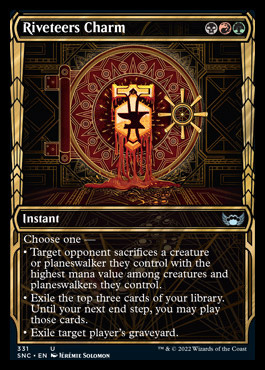
#11: The Charm Cycle
Pretty much every one of the Charms in New Capenna is decent aside from perhaps Cabaretti Charm. My favorites are Riveteer, Maestros, and Obscura. Riveteer Charm is just straight gas that can amass a lot of value, particularly with the impulse draw mode being used at an opponent’s end step. Maestros Charm is another card interesting in Arclight Phoenix decks since the first mode can allow the card to dump any Phoenixes you find into the yard and draw a card. Obscura Charm is notable for being able to resurrect a few notable permanents at instant speed, such as Kaito, little Teferi, and another card I’ll mention later.
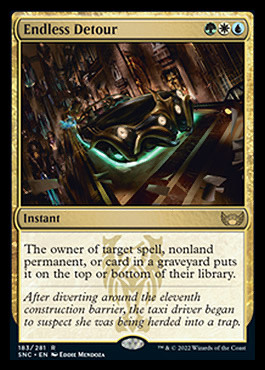
#12: Endless Detour
This can be a potentially vile card in a hard Control deck. If you pack at least two of these in a deck, you can use the first one to respond to a threat, and then use the second one to put the first one back on top of your library. And then do that again. And again. This lets a Control deck never draw out, which can be a miserable win condition as seen when big Teferi was in Standard.
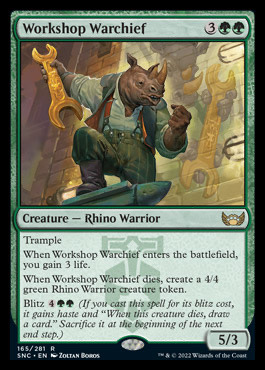
#13: Workshop Warchief
Thragtusk’s communist cousin. There’s not much to say here. Its Thragtusk with upside aside from the lack of blink synergies and a little less life gain… and I guess it requires an extra green mana to cast. Thragtusk is still a decent Magic card in slower games, and this is probably also good.
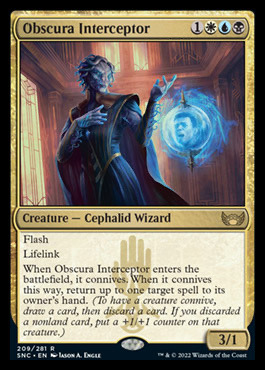
#14: Obscura Interceptor
There’s actually a surprising amount of tempo to be had with this creature. Its individual parts are underwhelming, but all combined together can make for a rather decent tempo play while also generating a 4/2 lifelink body at instant speed. Its probably not fast enough for older formats, but is quite a good card in slower formats and EDH.
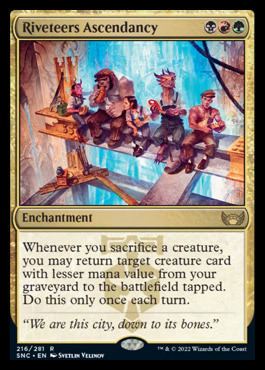
#15: Riveteers Ascendancy
This a work horse of a card in sacrifice decks. Lots of restrictions, but it can give its user a ton of value, particularly in EDH where there are more turns in one go around. Combine this with a sac outlet, and then have the bottom of your chain be something like a Doomed Necromancer. This can let a deck constantly cycle between a selection of cards over the turn cycle and generate tons of value. I think all but the most Spike-y of sacrifice decks want this in EDH, and I could even see it one day working in Standard or Pioneer… hell, maybe even Modern.

#16: Maestros Ascendancy
Kess but without legs and an added cost. This can be pretty easy to build around since cards like Young Pyromancer automatically generate sac fodder in these colors. The ability to cast spells again from the graveyard has always been valuable. This is no exception. It not being a creature also means it can recur board wipes without hitting itself.
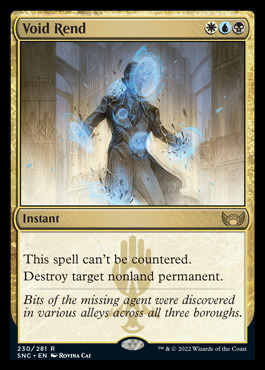
#17: Void Rend
Abrupt Decay but it can hit anything and is in better colors to be pitched to free spells like FoW, FoN, and Solitude. Cards like Murktide Regent require decks in any format to be able to hit creatures of any mana value, and this can’t be stopped aside from spells that bounce spells. A very valuable tool to have in any Esper deck’s arsenal.

#18: Raffine, Scheming Seer
And finally, Raffine! Am I biased? Maybe. But this is a valuable and potent attacker that can generate a ton of “card movement” across zones while also becoming a very large threat. The ward cost also means free spells cannot hit this for free. It can just be very hard for an opponent to cleanly answer Raffine, and the longer they wait the more absurd value she generates.
Honorable Mentions:
- Giada, Font of Hope
- Ledger Shredder
- Tenacious Underdog
- Ognis, the Dragon’s Lash
- Sanctuary Warden
3 notes
·
View notes
Text
Primeras impresiones con el Kit Powertronic.
Unas semanas atrás me contactó Juan de Powertronic Argentina para ofrecerme la posibilidad de probar un producto nuevo, automáticamente le contesté, que me parecía que yo no era público para este producto ya que no soy de manejar rápido ni de forma deportiva, es más disfruto andar de forma esencial. Una aclaración antes de seguir, yo no trabajo en redes ni soy youtuber etc. (mis ingresos vienen de mi profesión, soy odontólogo) solamente disfruto de mis motos y tomo fotografías, por ese motivo si acepto un producto para usar tiene que ser de utilidad ya que no tengo ingresos por realizar esa actividad, el producto tiene que ser divertido y reitero útil, si no prefiero rechazarlo. Después de la aclaración, le comenté a Juan que no me veía con el producto por mi estilo de manejo y que no quería instalarlo en mi moto ya que además soy súper obsesivo de no alterar la misma ni colocar accesorios que atenten con la garantía. Nota: Todos los accesorios que acepto para instalar y fotografiar son homologados por Royal Enfield Argentina o agencia oficial. Juan insistió y me envió toda la información del producto y realmente me di cuenta que tenía un prejuicio con este accesorio. Ahora si ya tengo el Powertronic, quickshifter y el map switch instalados en mi 650, y después de usarlo puedo hablar con la experiencia de uso.

El objetivo del kit es aumentar la potencia, velocidad final y la reacción de la moto para una conducción deportiva (no es mi interés), también optimiza la respuesta del acelerador, tanto acelerando y como comprobé después también al desacelerar, en altas y bajas revoluciones, explicado más claro: si acelero rápido, la moto entrega más torque y más rápido pero suave, no golpea la transmisión. Y al contrario si suelto el acelerador de golpe, el motor deja de entregar potencia pero no se siente el golpe en transmisión ni en la caja, ello disminuye el desgaste de todo en conjunto y hace que la moto sea más potente, pero placentera y segura.

Recordé de donde venía el prejuicio, en el 2008 era due��o de una HD Sportster 1200 R con filtro KN y escapes Vance&Hines, y coloqué el equivalente al Powertronic de esa época, el Fuelpak, la entrega de potencia era sumamente violenta, acelerar se sentía como un golpe y desacelerar parecía que uno presiona el freno. Esto no ocurre con el Powertronic, entrega más potencia, pero dosificada a la perfección, no comprometiendo la sensación deportiva de manejo.
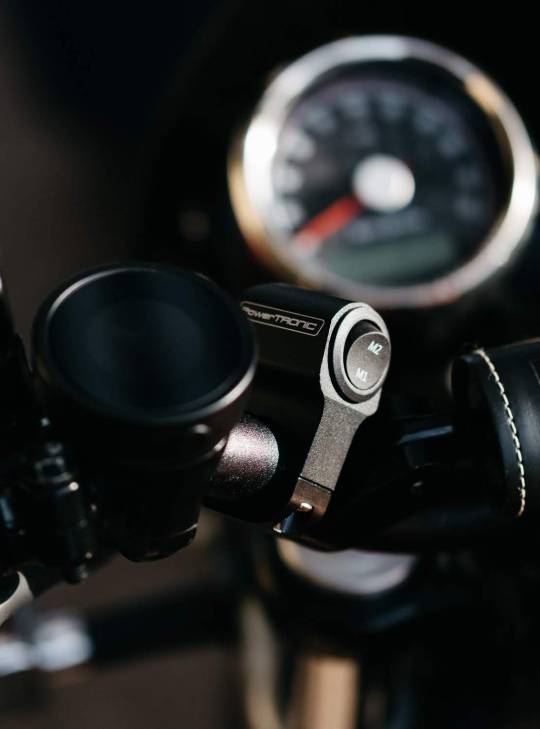
El kit consta de tres ítems: la ECU, que es el módulo que comanda la inyección, el cerebro de todos los procesos, evalúa las mediciones de los sensores y mejora la programación original de fabrica lejos, que ya de por sí es muy buena. El segundo es el quickshifter, es un sensor que colocado en el eje de la palanca de cambios, al pasar un cambio arriba le avisa a la ECU que baje las revoluciones en ese instante y el tiempo exacto para engranar la marcha siguiente sin usar el embrague. Es impresionante ingresar a la autopista, acelerando y subiendo cambios sin dejar de acelerar ni usar el embrague, ¡es mágico! El quickshifter avisa a la ECU cuando el pedal o palanca de cambios comienza a moverse hacia arriba y en ese instante, centésimas de segundo, bajan las revoluciones, entra el cambio y las revoluciones siguen subiendo! Igual que un automóvil con levas para cambios o autostick. El tercer componente es el Map switch, es un comando de dos posiciones que permite alternar entre dos mapas instalados en la ECU con solo accionarlo, sin desarmar nada ni apagar el motor, explicado… los dos mapas instalados en mi Interceptor estan preparados, el nro 1 (Race) para uso urbano, hace que entrega de torque se optimiza de bajas a medias revoluciones, ideal para ciudad y el mapa nro 2 (Race+ plus) la potencia se optimiza en todo el rango, pero mejor de medias a altas revoluciones. Mi uso de la moto es sesenta por ciento autopista y cuarenta por ciento ciudad, es excelente, por la ciudad con mapa nro. 1 Race, en cuanto subo a la autopista muevo el selector al nro.2 Race plus con toda la potencia a partir de 3500rpm y con el quickshifter habilitado que lleva la 650 cero a cien en instantes subiendo cambios sin embrague y sin dejar de acelerar.
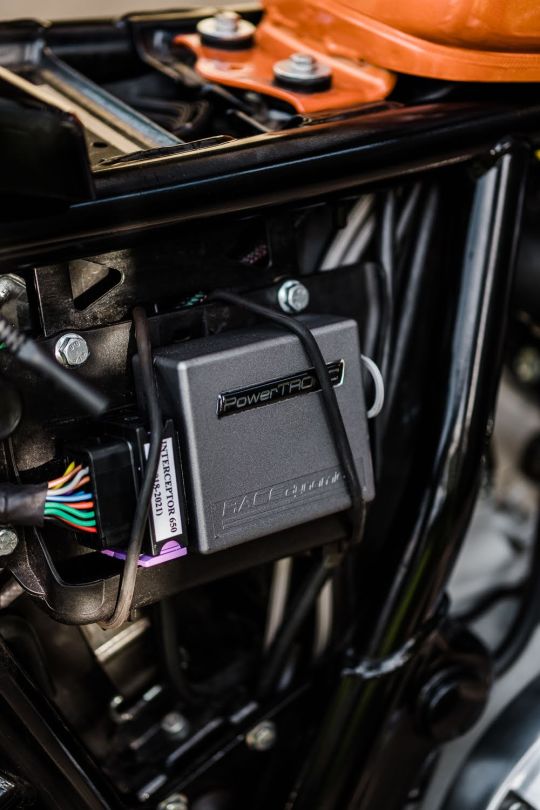
La instalación es simple, solo hay que remover el tanque de combustible y pasar el cableado, lo importante que todo es cien por ciento reversible, no se corta ningún cable ni se altera nada de la motocicleta, si deseo retirar el kit, todo queda original exactamente como estaba. La ECU Powertronic queda ubicada en la tapa lateral donde se alojan las herramientas. Una vez instalado, el kit incluye una ficha con leds, el Stock Coupler, tiene dos funciones: primero sirve para verificar si todo está bien instalado y la segunda si lo dejamos colocado la moto funciona original, importante si las reglamentaciones locales no permiten circular con el kit colocado (no aplica acá) o para revisiones técnicas obligatorias. Verificado todo, se coloca la ECU y se cargan los mapas con una PC, el software R-tune (se descarga de la web de Powertronic) y el cable USB provisto en el Kit. Es muy importante al finalizar la instalación calibrar la posición del acelerador, eso garantiza que la moto acelere de manera suave y precisa.
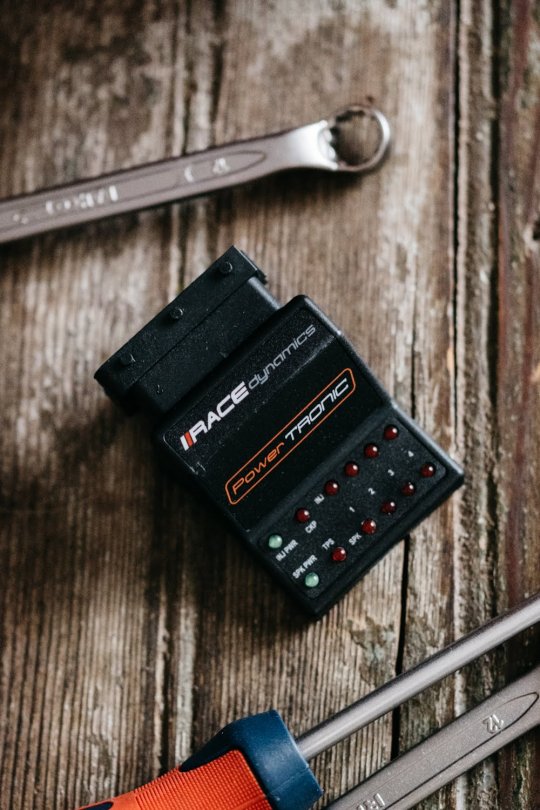

En resumen, es un accesorio como dicen los estadounidenses "must-have", es el paso casi obligado al la colocación de colas de escape y filtros de alto flujo, aunque hay que aclarar que sin ellos también se puede instalar el Powertronic, mejora notablemente el andar y la respuesta de la moto de fábrica y como gracias al Stock Coupler puedo volver al estado de fábrica en dos minutos, hacer la prueba stock vs powertronic confirma todos los beneficios que les comenté anteriormente ya que nos permite usar la moto en sus dos versiones al instante y sin pasar por el taller, solo tenemos que remover con la llave de encendido la tapa lateral y reemplazar la ECU por el Stock Coupler. A medida que pase el tiempo de uso voy a tener más experiencias para contar y escribir.
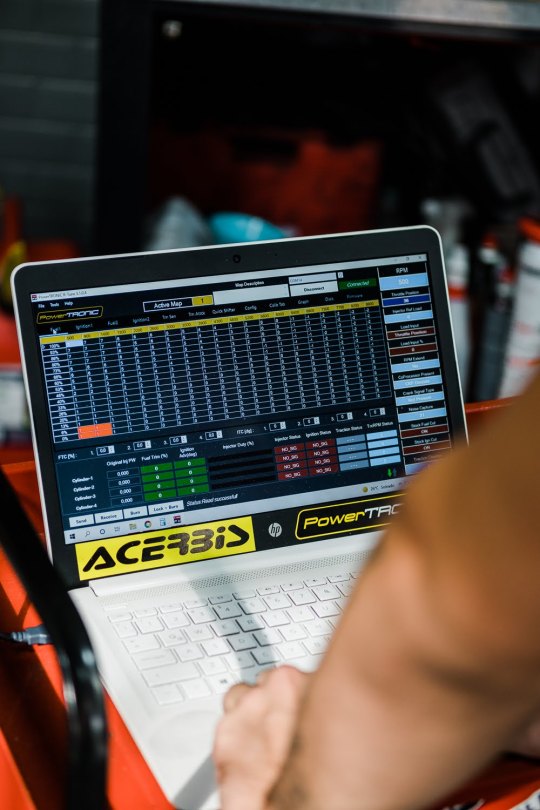
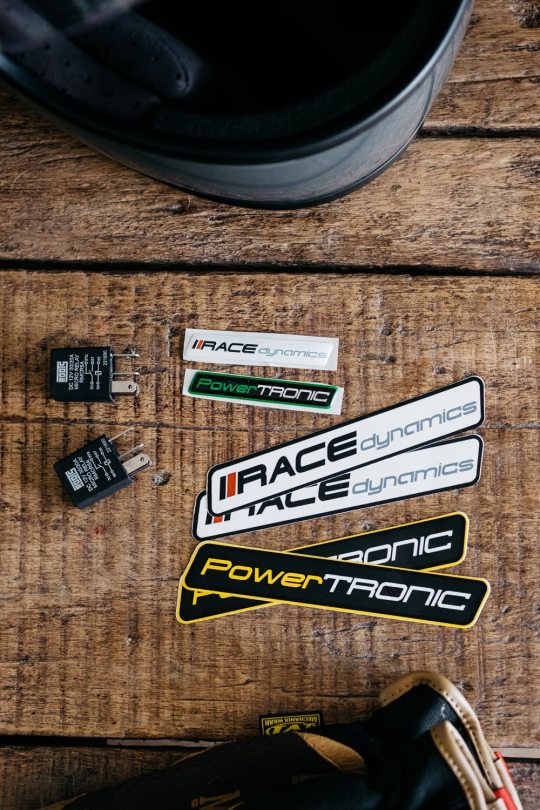
Mil gracias por llegar hasta acá y espero sus comentarios.
Me olvidé, el kit también trae calcos, fundamental para fanáticos y las herramientas que estaban en el lugar dónde se encuentra ahora la ECU Powertronic entran perfectamente debajo del asiento, por delante del anclaje del asiento.
Nota: las observaciones vertidas en este artículo están basadas en mi experiencia personal, no pretendiendo de ninguna manera ser un artículo cientifico.
Marcelo Esperon (de Coghlan)
5 notes
·
View notes
Text
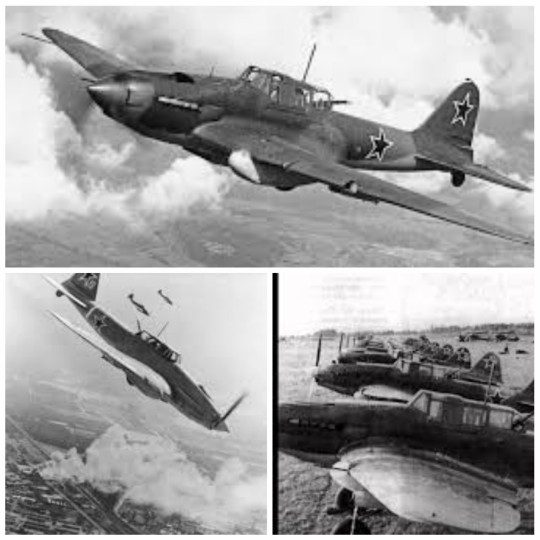
• Ilyushin Il-2 Ground Attack Aircraft
The Ilyushin Il-2 or Shturmovik was a ground-attack aircraft produced by the Soviet Union in large numbers during the Second World War. With 36,183 units of the Il-2 produced during the war.
The Il-2 was designed by Sergey Ilyushin and his team at the Central Design Bureau in 1938. TsKB-55 was a two-seat aircraft with an armoured shell weighing 700 kg (1,540 lb), protecting crew, engine, radiators, and the fuel tank. Standing loaded, the Ilyushin weighed more than 4,700 kg (10,300 lb), making the armoured shell about 15% of the aircraft's gross weight. Uniquely for a World War II attack aircraft, and similarly to the forward fuselage design of the World War I-era Imperial German Junkers J.I armored, all-metal biplane, the Il-2's armor was designed as a load-bearing part of the Ilyushin's monocoque structure, thus saving considerable weight. The prototype TsKB-55, which first flew on October 2nd, 1939, won the government competition against the Sukhoi Su-6 and received the VVS designation BSh-2 (the BSh stood for "Bronirovani Shturmovik" or armoured ground attack).
The BSh-2 was overweight and underpowered, with the original Mikulin AM-35 1,022 kW (1,370 hp) engine designed to give its greatest power outputs at high altitude. Because of this it was redesigned as the TsKB-57, a lighter single-seat design, with the more powerful 1,254 kW (1,680 hp) Mikulin AM-38 engine, a development of the AM-35 optimised for low level operation. The TsKB-57 first flew on October 12th, 1940. The production aircraft passed State Acceptance Trials in March 1941, and was redesignated Il-2 in April. Deliveries to operational units commenced in May 1941. One of the first 1940 photographs of the Il-2 show it equipped with two MP-6 23 mm autocannons developed by Yakov Taubin. The MP-6 gun weighed 70 kg and developed an initial muzzle velocity of 900 m/s. It operated on the short recoil principle and had a rate of fire of about 600 rpm. In the early Il-2 prototypes, these guns were fed by 81-round clips. In flight, these clips sometimes became dislodged because of their large surface, which caused them to experience significant aerodynamic pressure. Subsequently, in May 1941, development of the MP-6 gun was terminated and Taubin was arrested and summarily executed in October that year.
In early 1941, the Il-2 was ordered into production at four factories, and was eventually produced in greater numbers than any other military aircraft in aviation history, but by the time Nazi Germany invaded the Soviet Union on June 22nd, 1941, only State Aviation Factory 18 at Voronezh and Factory 381 at Leningrad had commenced production, with 249 having been built by the time of the German attack. Production early in the war was slow because after the German invasion the aircraft factories near Moscow and other major cities in western Russia had to be moved east of the Ural Mountains. Ilyushin and his engineers had time to reconsider production methods, and two months after the move Il-2s were again being produced. After threats by Stalin to increase production, Stalin's notion of the Il-2 being 'like bread' to the Red Army took hold in Ilyushin's aircraft plants and the army soon had their Shturmoviks available in quantity.
The first use in action of the Il-2 was with the 4th ShAP (Ground Attack Regiment) over the Berezina River days after German invasion began. The aircraft was so new that the pilots had no training in flight characteristics or tactics, and the ground crew no training in servicing or re-arming. The training received enabled the pilots only to take-off and land; none of the pilots had fired the armament, let alone learned tactics. There were 249 Il-2s available in June 1941. In the first three days, 4th ShAP had lost 10 Il-2s to enemy action, a further 19 were lost to other causes, and 20 pilots were killed. By July, 4th ShAP was down to 10 aircraft from a strength of 65. Tactics improved as Soviet aircrews became used to the Il-2's strengths. Instead of a low horizontal straight approach at 50 metres altitude, the target was usually kept to the pilot's left and a turn and shallow dive of 30 degrees was used. Although the Il-2's RS-82 and RS-132 rockets could destroy armored vehicles with a single hit, they were so inaccurate that experienced Il-2 pilots mainly used the cannon. Another potent weapon of the Il-2s was the PTAB shaped charge bomblets (protivotankovaya aviabomba, "anti-tank aviation bomb").
PTABs were first used on a large scale in the Battle of Kursk. The Il-2 was thereafter widely deployed on the Eastern Front. The aircraft could fly in low light conditions and carried weapons able to defeat the thick armor of the Panther and Tiger I tanks. In the Battle of Kursk, General V. Ryazanov became a master in the use of attack aircraft en masse, developing and improving the tactics of Il-2 operations in co-ordination with infantry, artillery and armored troops. Il-2s at Kursk used the "circle of death" tactic: up to eight Shturmoviks formed a defensive circle, each plane protecting the one ahead with its forward machine guns, while individual Il-2s took turns leaving the circle, attacking a target, and rejoining the circle. Ryazanov was later awarded the Gold Star of Hero of Soviet Union twice, and the 1st Assault Aviation Corps under his command became the first unit to be awarded the honorific title of Guards. In 1943, 26 Shturmovik sorties were conducted. About half of those lost during were shot down by fighters, the rest falling to anti-aircraft fire.
During the Battle of Kursk, VVS Il-2s claimed the destruction of no less than 270 tanks (and 2,000 men) in a period of just two hours against the 3rd Panzer Division. Perhaps the most extraordinary claim by the VVS's Il-2s is that, over a period of four hours, they destroyed 240 tanks and in the process virtually wiped out the 17th Panzer Division. The 17th Panzer did not register any abnormal losses due to aircraft in the summer of 1943, and retreated westwards with Army Group South later in the year, still intact.
The main problem with the Il-2 was the inaccuracy of its attacks. Towards the end of war, the Soviets were able to concentrate large numbers of Shturmoviks to support their main offensives. The effect, however, was often more psychological than actual physical destruction of targets, particularly against dug-in and armored targets. While some attacks against large unprotected targets such as horse and truck convoys and railyards had devastating results, attacks against dug-in point targets were usually ineffective. The frequent duels between dug-in 20 and 40 mm AA guns and Il-2 attackers never resulted in the complete destruction of the gun, while many Il-2s were brought down in these attacks. The heavy armor of the Il-2 also meant that it would typically carry only comparatively light bomb-loads, which together with the poor accuracy of its attacks made it a far less deadly attack aircraft than contemporary Allied fighter-bombers such as the Republic P-47 Thunderbolt and Hawker Typhoon.
Thanks to the heavy armor protection, the Il-2 could take a great deal of punishment and proved difficult for both ground and aircraft fire to shoot down. A major threat to the Il-2 was German ground fire. In postwar interviews, Il-2 pilots reported 20 mm (0.79 in) and 37 mm (1.46 in) artillery as the primary threat. While the fabled 88 mm (3.46 in) calibre gun was formidable, low-flying Il-2s presented too fast-moving a target for the 88's relatively low rate of fire, only occasional hits were scored. Owing to a shortage of fighters, in 1941–1942, Il-2s were occasionally used as fighters. While outclassed by dedicated fighters such as the Messerschmitt Bf 109 and Focke-Wulf Fw 190, in dogfights, the Il-2 could take on other Luftwaffe aircraft with some success. While the Il-2 was a deadly air-to-ground weapon, and even a fairly effective interceptor against slow bombers and transport aircraft, heavy losses resulted from its vulnerability to fighter attack. Losses were very high, the highest of all types of Soviet aircraft, though given the numbers in service this is only to be expected.
Some surviving examples still remain of this aircraft one is 1872452 – Airworthy with the Wings of Victory Foundation in Moscow. It was recovered in 2015 from the bottom of a lake near Murmansk and restored. Another is under restoration to airworthy condition at the Vadim Zadorozhny Museum of Technology in Moscow. Finally an additional is at the Flying Heritage & Combat Armor Museum in Everett, Washington. It incorporated parts of an aircraft recovered from a swamp near Pskov and was restored.
#second world war#world war 2#soviet union#airforce history#aviation#military aircraft#wwii#aircraft#soviet air force#military history
69 notes
·
View notes
Text
AIM-54 Phoenix in Iran
For me one of the most incredible fighter aircraft to be built and put into service was the Grumman F-14 Tomcat

However what made the aircraft one of the most potent fighters was its weapon control system linked with its powerful AN/AWG-9 radar, a system capable of tracking 24 targets and guiding 6 missiles to 6 of these threats almost 100 miles away. To give the Tomcat it’s long claws an incredible weapon was introduced that gave the Tomcat its legendary status: the Hughes AIM-54 Phoenix long-range Air-to-air missile.
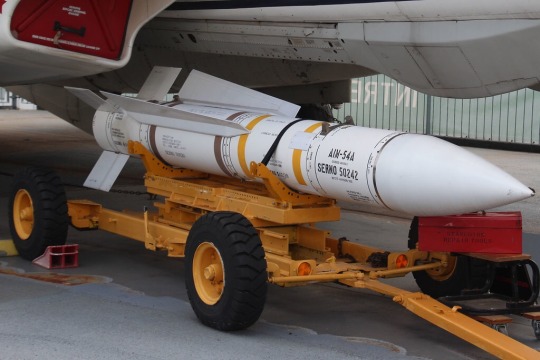
With a range of almost 100 miles, semi-active and active radar features and the ability to home on aircraft attempting to deflect the weapon via ECMs and also proved impossible to jam it was one of the most state of the art aircraft weapons introduced at the time in the 1970s. However due to its size, complexity and need for a powerful radar to fully utilise the weapon it was only used on the F-14, which means only countries who bought the Tomcat could use this missile which came down to two nations: the US and Iran.
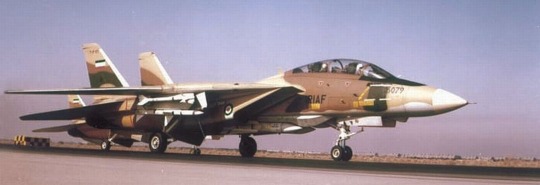
With Iran’s decision to acquire the F-14A came contract “Persian King” being signed in 1974. As well as 80 aircraft, training and spare parts and engines for 10 years, the contract also called for a total of 714 operational AIM-54A Phoenix missiles to be built and delivered to Iran. Whilst the Phoenix missiles built for Iran were slightly downgraded electronically to ensure it was less effective against US aircraft and their ECMs the weapon was just as potent as its US counterpart.
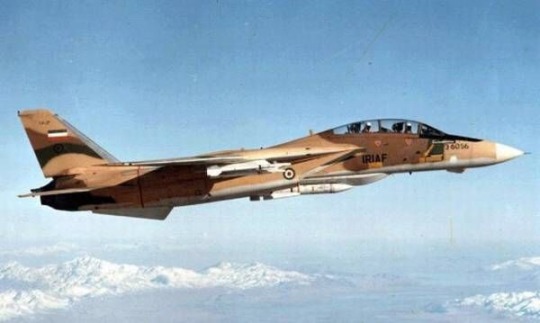
However in 1979 and Islamic Revolution swept through Iran and with it the US Friendly Shah, this along with the Hostage crisis at the US embassy shortly after led to the US turning its back on its former ally and most Shah friendly personnel fleeing the country for fear of torture at the hands of the new Islamic Government.
With the departure of Grumman and US Navy technicians from Iran and rumours that both the F-14As and the AIM-54As had all been sabotaged and made non-operational by the leaving personal it was assumed the Iranian crews now in charge would be unable to fix the aircraft and wepons, the US hoping the highly advanced F-14s would be non-operational in the hands of the new and strongly anti-western Iranian Reigeme as these could now represent a clear threat to others in the Gulf. The imprisonment and even executions of those trained on the aircraft and the weapons seemed to ensure this was the case.
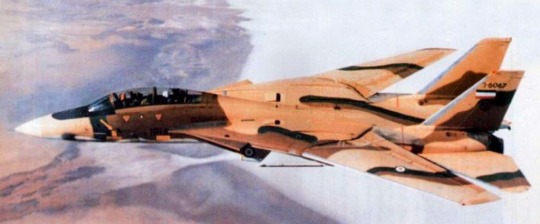
However in July of 1980 tensions and border clashes with Iran’s neighbor Iraq led to commanders of the new IRIAF to begin the process to get a number of F-14s back to operational status. A number of the damaged Phoenix missiles from attempts of Sabotage were also repaired and brought back to operational service.
On the 13th of September 1980 a border intrusion by an Iraqi MiG-23MS led to a historic moment for the Tomcat: The MiG was shot down by a single AIM-54A, the first kill with the mighty Phoenix. With the War with Iraq breaking out on the 22nd September 1980 a large number of imprisoned pilots and ground crew were slowly released from jail and were sent back to their units and by 1981 a rather astonishing 60 Tomcats were now operational, an incredible feat for the now cut-off nation without any outside support.
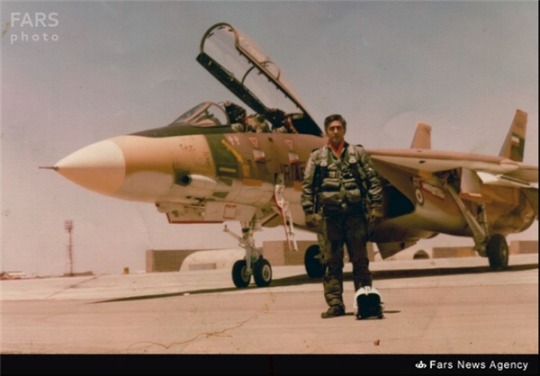
With more and more engagements came much needed combat experience and lessons were learned by the Iranians on how to use the Tomcat and how to employ the AIM-54A in combat. One of the more noticeable examples was the standard load reduced from the usual 4 Phoenix missiles from the start of the war to just 2.

This was done for a number of reasons. First was because there were only 224 rounds in country after the supply was cut off by the revolution so these rounds had to be used sparingly.
Second was the weight of 4 missiles reduced the Tomcat’s ability to dogfight, therefore the reduction of just 2 AIM-54As under the forward Pallets ensured if an opportunity to use the weapons were missed and the Tomcat was forced into a close in fight it still retained its superior manovering ability as the missiles mouted under the forward fuselage had no effect on the F-14s aerodynamics.
And lastly the Phoenix provided another useful trait for an outnumbered Air Force: Fear. Due to Iraqi pilots being trained to a much lower standard compared to the American-trained Iranian aircrews and their Soviet-made aircraft being fitted with poor RWR equipment led to a number of aircraft being shot down before the formation knew what hit them, which meant all it took was one Iraqi aircraft to be shot down to turn an entire mission formation around and abandon mission. Iraqi pilots often ran when the presence of an F-14 was known, as well as known hunting grounds were avoided at all costs by both Iraqi and Saudi pilots knowing the terrifying capabilities of the Tomcat and the Phoenix.
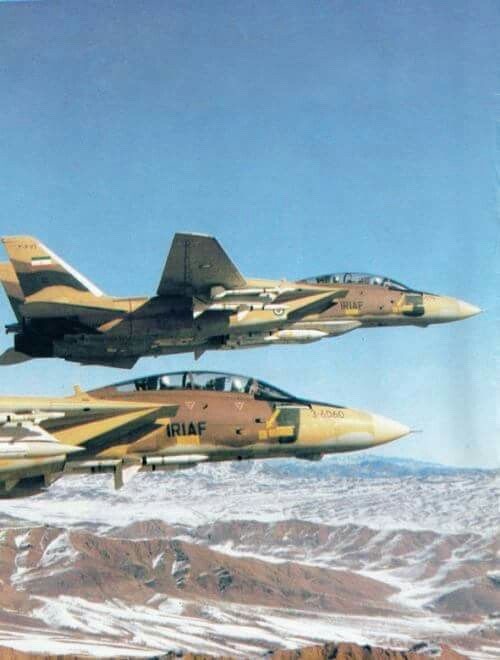
With the advantages of the F-14 clear over anything the IrAF had in its inventory the Tomcat crews used the aircraft and the Phoenix to its full advantage, often using utilising the Phoenix at long range and the big warhead proved deadly, sometimes downing more than one aircraft with the detonation, such as in December of 1980 when a single AIM-54 downed 2 MiG-23s and in January the following year a Phoenix downed 3 MiG-23s, with the 4th aircraft damaged, proving that 2 missiles were plenty for a typical mission as the fear of more attacks would drive most formations home.
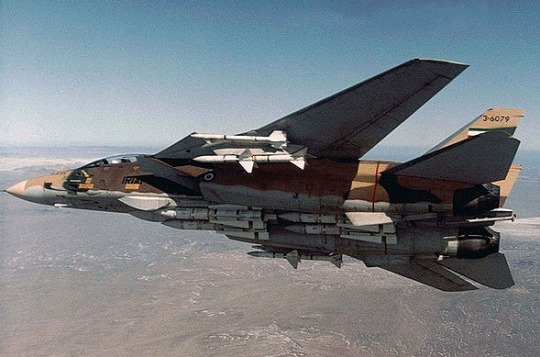
However by 1985 the stocks of operational AIM-54As were starting to be depleted. A combination of 5 years of hard war and the Phoenix missile’s components going past their shelf life as missiles need update kits to keep them in operational condition, especially a complex weapon like the Phoenix which has many sensitive and sophisticated parts to work and many of these became inoperable. This led to a experimental series of tests called “project SkyHawk” to see if the MiM-23 Surface-to-Air missile could work as a aircraft weapon, these tests proved ineffective and the stock of Phoenix missiles were boosted by other means like the Iran-contra affair in which a number of upgrade kits were provided to Iran by the US and a fair number of missiles were brought back to frontline status.
The Phoenix proved to be an incredibly effective weapon against every aircraft in the Iraqi Air Force, even against the most advanced aircraft like the Mirage F.1, MiG-25 and the Tupolev Tu-22B which possessed good RWRs and ECMs. By the end of the war in mid-1988 the Phoenix missile had been responsible for the 40 out of the estimated 160 aircraft shot down during the war, the missile proving incredibly effective and contributed to why in my opinion the F-14 was by far the most effective aircraft in the Iran-Iraq war. Despite depleting numbers of both Tomcats and it’s AIM-54s they still proved superior in the engagements it took part in.
Interesting how Iran showed the effectiveness of the AIM-54 in combat unlike the US who introduced the weapon as the US Navy have only had limited opportunities to use the weapon such as the Gulf war of 1991 where in a number of possible uses of the Phoenix the weapon didn’t work or the permission to fire was not granted due to fears of friendly fire. Only one kill was almost scored in 1999 by a US Phoenix in Iraq but the missile just missed by a few feet.
Today the original AIM-54 May still be in service with the IRIAF although it’s been very rarely seen on the 20-50 Tomcats estimated to be in service. With advancements in the aircraft Industry the Iranians have began a effort to arm its F-14s with modern domestic versions of the old US-made weapons originally supplied back in the 70s, most notably is the Fakour-90, a copy of the Phoenix which will be the new Long-range armament of the Tomcat in the coming years, coupled with the upgraded F-14A-M this could provide a suitable fighter/Interceptor for years to come although given this is Iran we are talking about it could be a poor attempt at modernisation and these could just be false.
But whatever the case the Iranian use of the AIM-54 during the Iran-Iraq proved beyond doubt the huge and complex AIM-54 combined with the AN/AWG-9 was an astonishing weapon system.
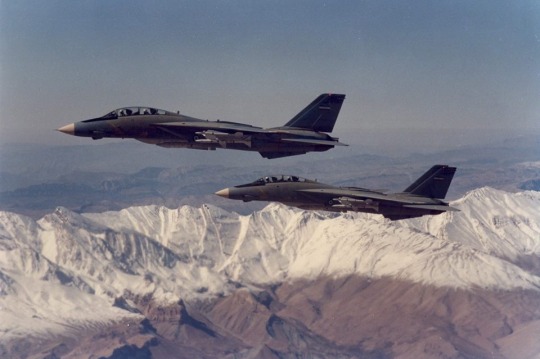
#grumman f 14 tomcat#f14atomcat#f14tomcat#f14#f14a#Tomcat#iriaf#islamic republic of iran air force#iran#iranian airspace#aim 54#phoenix#aim 54 phoenix#military aviation#fighter jet
8 notes
·
View notes
Text

The cover artwork of the novel Firefox by Craig Thomas depicted a MiG-25, and the plane was described similarly to the MiG-25 in the book.
The Soviet MiG-25 (NATO code-name “Foxbat”) was a high-speed interceptor and reconnaissance aircraft. The aircraft entered service in 1970 and has a top speed of Mach 2.83, powerful radar, and could carry up to four air-to-air missiles.
A capable interceptor, the MiG-25 was widely exported by the Soviet Union.
The MiG-25’s capabilities were not discovered until 1976 when Viktor Belenko, a Soviet MiG-25 pilot, defected to Japan.
Subsequent analysis revealed a simple-yet-functional design with vacuum-tube electronics, two massive turbojet engines, and sparing use of advanced materials such as titanium.
The Soviet government put pressure on Japan, demanding the delivery of the purloined ‘Foxbat’ pronto. Since there were no legal reasons not to, the MiG-25 was returned, in dismantled and crated condition. The Japanese did it on purpose to cover up the ‘surgery’ they and the U.S. intelligence experts had undertaken on the MiG.

However the Soviet experts were quick to find out just how much the West actually knew. When the MiG-25 was returned to the USSR it was determined that the Americans had run the engines and measured the aircraft’s infra-red signature and also made a detailed analysis of the systems and avionics, including the radar, and the structural materials. Not knowing how to operate the equipment, the Americans had damaged some of it and had to make hasty repairs (foreign fuses and resistors were discovered in the radar set).
The incident got the world press going wild with stories about the MiG-25 and U.S. Defence Secretary Schlesinger stated that the new Soviet interceptor was a sufficiently potent weapon to bring about drastic changes to the Western weapons systems and strategies.
Belenko’s defection was also mentioned in the novel Firefox by Craig Thomas, on which Clint Eastwood’s movie is based. According to an interesting post appeared on Quora, in the book there’s a mail conversation (the snail mail kind, since it was published in 1977 and takes place a short time after) in which they discuss Belenko’s defection. Someone argues that the new MiG-31 Firefox is not a big deal, since they already have Belenko’s MiG-25, while someone else argues that the MiG-31 is a completely different beast.

Clint Eastwood in Firefox
Then, as MiG-31 flies for the first time, NATO has everything in the air to spy on it, and nobody could see anything on the radar. They conclude that the MiG-31 not only is faster than anything and features a revolutionary fire control system controlled by thought, but also is invisible to radar, and that they have to steal one.
And that’s when the book begins in earnest, and also where the movie starts.
Since the defection of Victor Belenko was widely mentioned at the time, the publisher had an unusual large first print run, gambling on the publicity of Belenko’s defection to push up the sales.
In fact Craig Thomas was inspired by the awesome performance of the MiG-25, and then Belenko defected as he was finishing the book and thus included in the letters.
Fun fact: the cover artwork depicted a MiG-25, and the plane was described similarly to the MiG-25 in the book. In the sequel, Firefox Down, the description was more like the MiG-31 in the 1982 movie.

MiG-31 Firefox
Full-scale MiG 31 Firefox mockup used in the film “Firefox” parked at Van Nuys Airport, California in May 1982
Fun fact 2: The artwork on the Swedish paperback translation of Firefox instead depicted a canard and double-delta aircraft, pretty similar to the Swedish JA-37 Viggen.

JA-37 Viggen
Photo credit: Screenshot from YouTube video, CIA, Dmitriy Pichugin and MilborneOne via wikipedia
Dario Leone
Dario Leone is an aviation, defense and military writer. He is the Founder and Editor of “The Aviation Geek Club” one of the world’s most read military aviation blogs. His writing has appeared in The National Interest and other news media. He has reported from Europe and flown Super Puma and Cougar helicopters with the Swiss Air Force.
NEXT US Navy selects Commercial Dismantlement plan to dismantle and dispose USS Enterprise (CVN-65), the world's first nuclear-powered aircraft carrier » PREVIOUS « F-8 Pilot recalls how a good brief by his Flight Lead saved his bacon during a night carrier landing with his Crusader radio not working
Leave a Comment
SHARE
PUBLISHED BY
Dario Leone
TAGS:
MiG-25MiG-25 FoxbatMiG-31MiG-31 FoxhoundViktor Belenko
t
Fedotov MiG-25RB altitude world record
10 notes
·
View notes
Text
Warmth
@heroicmeep ‘s Meep and @jaxstronomy ‘s Martin find their way to @deltheor Sydney’s hideout, where @lightbrand ‘s Pandora and another unexpected ally are waiting...
“And that, Pandora, is why we were patient.”
The room was deathly silent. Sydney’s voice had a way of carrying, a dark echo in the wind, the mind, the soul. Meep could feel the pressure building in her brain, a constant throbbing pain, courtesy of the man on the throne. Martin had stopped walking, now drilling holes into Sydney’s skull with his darkened eyes. The moment had come for retribution. Meep only hoped that she’d have the strength to bring this nightmare to an end.
“You see,” Sydney continued without further acknowledgement, “Now we get to watch them struggle. Not that we didn’t before, which was deliciously entertaining - I wish I had popcorn to enjoy the times you had to carry him around.” He waved a finger at Meep, then Martin. Martin looked down. “Anyways, welcome, welcome! We’ve been waiting oh so patiently to give you this Red Carpet Welcome, we’d ask if it lives up to your standards, but we don’t particularly care about them.”
Meep couldn’t help but ask a quiet question. “Who do you mean...we?...”
Sydney started to laugh, and she shrank back, biting her lip. “Well, Sailor Mercury, my pet Patches is still here.”
“I’m not your pet.” Pandora tried to snap, but her voice seemed oddly hoarse.
He ignored the comment. “But secondly, I’ve been...blessed, if you please...by another prized pick of the litter.”
In that moment, the pain subsided. She watched with morbid curiosity as Sydney’s shoulders relaxed and his eyes closed. A faint smile appeared on his pierced lips, not smug, not flirtatious. He looked at peace.
Then Meep felt it, the presence of another mind in the room, another potent force. All the bruises, the scrapes, the scars, physical, mental - something brushed over them. They were small kisses, small wishes, they brought comfort and warmth to her body. She could practically feel the arms around her, pulling her in for a loving embrace. For once during the mission, Meep felt like everything would be okay.
One quick glance to her right indicated that Martin was feeling the same serenity. Pandora, the empty husk Sydney had called his companion, stepped away from the throne, her footsteps silent against the floor. “You...that’s not you. It can’t be.”
She turned towards Meep and Martin, her eye wide. “What the fuck are you doing to him?”
“It’s...it’s not me,” Meep stammered. Martin was only able to shake his head for an answer.
There was a faint noise, carried only by the nonexistent breeze. A chuckle. It didn’t belong to anyone there. Seconds later, Sydney opened his eyes, his smile growing wider, wider. From behind the throne a fifth figure joined them, preferring the safety of the shadows. The light was able to capture the faint glint of a knife in the figure’s hand. A pupiless indigo gaze, unblinking, answered the unanswered.
“...Pon...go?...” Meep whispered.
The lovable Interceptor smiled.
“Good to see you again, Meep!”
It would’ve been endearing in any other situation, hearing that innocent tone of his. But now there was a dark edge to it; he’d sliced that knife through the air without having to move an inch. Meep felt a chill race down her spine as Sydney stood up to greet him, throwing his cape to the side for an added dramatic swish. It was Pongo who slipped his arm around Sydney’s waist, pulling him closer, all while staring down at Meep and Martin.
She couldn’t help it. The corners of her eyes started to sting as tears ran down her cheeks. “N-No...you’re lying, you wouldn’t do something like this…”
“The mind’s a fragile thing - though you knew that already, didn’t you?” Sydney smirked. “And while I’d love to monologue about the specifics to our little ‘partners in crime’ layout, that’d be too damn easy.”
It wasn’t the air that was warming up, but Meep was sweating now. She hadn’t fought a mind like this before, and while it was easier to push aside than Sydney’s, it left more of a strain on her heart. This wasn’t supposed to feel good, but it did, and that made her want to scream. Why did she want to throw aside her defenses? Why did she want to give in?!
Meep couldn’t move. Pongo’s Will was growing, enshrouding her not in darkness, but in love. Maybe that was why it was so powerful - she hadn’t felt anything like this since before the start of this damned mission. She had no control over the gentle smile finding its way onto her lips, no control over herself as she watched Sydney pull Pongo closer again for - could it be called a kiss?! No, he was attacking Pongo’s mouth, and what frightened her the most was when Pongo reciprocated it. Pandora made a small noise of discomfort, though Meep couldn’t tell if it was because of the kiss, or because she was losing herself.
Martin growled something she couldn’t hear, but he got louder with his next statement. “You’re disgusting.”
He drew his knife and charged forward, and the sudden burst of energy stopped the two lovers - NO, they couldn’t be lovers, Pongo wouldn’t - it stopped them; they pulled apart and watched the silver haired Harrier sprint towards them. Pongo grinned, and the heat grew stronger. Meep found it in herself to fight, to move forward, to help Martin put an end to this stupid fucking mission. Their knives were drawn and pointed and ready to kill.
Pandora simply watched.
Martin’s target was Sydney. Both Interceptors darted away from each other as Sydney drew Martin towards the left side of the throne. The clash of knives rang through the air before Meep reached Pongo. His stance was different than Sydney’s, shoulders relaxed and a dark smile still plastered on his face. Meep stopped, her grip on her knife tightening.
“This can’t be you.”
“How would you know?” Pongo’s head tilted curiously. “Humans have a curious way of hiding their true selves. How long was I able to hide my connection to Mira?”
“You didn’t!” Meep cried, “You told me as soon as I asked! You’re honest and good and you’re not - you can’t be on his side!!”
The smile disappeared.
And when it left, the warmth began to turn into a fire, a fire that consumed her very mind and left her screaming, screaming so loud that she could hardly hear Pongo’s voice inside her head.
“Aw, looks like someone needs a hug.”
#xenoblade x#Warmth: Short Story#Meep#Martin#Pandora#Sydney#Pongo and Brainjack is a BAD IDEA#however I love this completely horrible idea#don't be surprised if I write more fics based around it
9 notes
·
View notes
Note
AU headcanons: Avatar: The Last Airbender/Star Wars crossover
Yes, now this is what I’m talking about! I’ve got quite a few, but I tend to put them in roles that might not be agreeable, so bear with me if you don’t like them that much. I’ll be focusing on individual characters, some of which I have multiple head-canons depending on the era. I will also be putting which Star Wars Era these head-canon’s fall in. I feel that’s especially relevant.
HC #1 - Azula v.1 - Rise of the Empire/Galactic Civil War Eras - Imperial Fighter Pilot - Azula is an imperial captain in command of the 111th Imperial Fighter Wing, better known as the “Star Circus”, attached to a Star Destroyer detachment tasked with patrolling a sector of the Outer Rim. She’s an ace pilot and a veteran of multiple skirmishes and pitched battles with criminal syndicates and rebels fighter squadrons. She pilots an dark-blue colored TIE Interceptor and has her kills painted on the side of her craft’s fuselage in bright gold by a the mechanics - she has 80 confirmed kills. For exceptional personal achievement she was awarded the “Imperial Badge of Merit” by the Empire upon review and analysis of her actions, a few years after they had been accomplished. Friends and foes in the sector have dubbed her the “Blue Moff”.
HC #2 - Sokka v.1 - Rise of the Empire/Galactic Civil War Eras - Rebel Fighter Pilot - Sokka is a rebel lieutenant attached to the 332nd Fighter Squadron, better known as the “Spitfires”. They are tasked with guarding and escorting rebel transports traveling through sectors of the Outer Rim. He’s an ace pilot and mechanic, having survived numerous engagements with Imperial fighters across areas of the Outer Rim. His current star-fighter is a an X-Wing. He paints pin-ups on the side of his fuselage himself, along with his 60 confirmed kills. Interestingly enough he also paints his five “wounded awards” on the fuselage too, called “Redbirds” by Alliance personnel, which are shaped like the symbol of the Rebel Alliance. As such his friends and foes have come to know him as “Red Bird” or alternatively “Star Bird”.
HC #3 - Toph - Old Republic Era - Miralukan Rogue - Toph is an especially force sensitive sentient humanoid born without eyes, as is the case with her kind, the Miralukans. This did not bother her as her kind learned to perceive the environment around them using the force. As a young girl gifted in the force, she took to traveling like so many of her kind and lived a nomadic life wandering from planet to planet, gathering experience in the ways of the force. Unlike her kind, which were content to live peaceful nomadic lives, she opted to live her life through fighting and aggression, testing her abilities, which eventually led her to become an outlaw with extremely potent force powers. Amazingly, she was neither tempted by the Dark Side nor compelled to follow the ways of the Jedi.
HC #4 - Yue - The Clone Wars Era/Rise of the Empire Eras - Outer Rim Queen v.1 - Yue is the queen of a world in the Outer Rim. Her home world is more of a small moon that orbits a massive red gas giant and is covered in ice and snow, with small seas that freeze over, towering gray mountains, and a hardy people. Though the planet’s capital possesses a spaceport it is merely a small mid-stop to far more wealthier worlds and settlements around the planet struggle. Isolated and out of the way, the Clones Wars nonetheless found its way to her world.
Representatives from both the Confederacy and Republic attempted to woo her to their respective sides and her people became split on the issue of remaining neutral or choosing a side. When her father, the former king and her current advisor, was killed in an attempted coup led by her former husband, Hahn, in an attempt to sway the planet toward the CIS, Republic commandos intervened on her request, forced to make the decision. These commandos along with her most loyal supporters, defeated Hahn, his faction, and the CIS detachment sent to enforce the change. In the end her planet was made into a small refueling post for Republic starships heading to far away battlefields, garrisoned by a detachment of clones. And so her reign continued, catering to a faction that ultimately did not want to be there, attempting to help her people as best she could. When the Republic morphed into the Galactic Empire her planet once again found itself under foreign influence in the form of stormtroopers.
HC #5 - Azula v.2 - Rise of the Empire/Galactic Civil War Eras - Outer Rim Queen v.2 - Azula is a princess, daughter to a small Outer Rim planetary ruler named Ozai. Her home world is a desert moon that orbits a massive blue gas giant, wracked by sand storms, sweltering heat, yet abundant in untapped resources. Although it was part of the Republic its declaration of neutrality during the Clone Wars left it untouched by the warring factions, allowing Ozai to shake off pesky Republic regulations and laws to rule the world as he saw fit. Despite a small spaceport within the capital city that attracts trade, the planet as a whole is ultimately a backwater ruled by a overly-lavished ruling family. Many struggle to survive and some turn to the nascent Rebel Alliance for salvation against her father’s oppressive rule. Despite pleas from her brother, Zuko, for change he is ultimately scarred and exiled. As the local population in the capital rose up against Ozai with the help of underground cells from the Rebel Alliance Azula fled with her most loyal followers and the last of her family’s treasures, her father killed and her brother aiding the rebels.
Exiled, she sought the help of the new Galactic Empire to regain her planet. She eventually found help in the form of a Imperial captain named Sokka stationed on another backwater who commanded an Imperial fighter wing. Wooed and charmed, he was eventually enlisted to aid her, even so far as gaining reluctant approval from his superiors. She also found help in the form of a band of bounty hunters led by a woman simply called “June”. Together, with promises of glory and treasure, Azula assembled her small patch work force and assault the planet. Surprisingly the rebel forces were defeated, but her brother escaped capture as he left with the fleeing rebels. And so Azula declared herself queen of her desert moon, managing to just barely pay off the bounty hunters’ high service costs and rewarding the daring Imperial captain with great favors and comfier accommodations.
An Imperial presence was quickly set up, with stormtroopers patrolling the streets of her capital and ensuring law and order. Through crafty diplomacy and intelligence she manage to bargain a deal with Imperial authorities that allowed the moon’s resources to be extracted with Imperial machinery while also receiving a percentage of profits. In a sense, Azula had made her planet a tributary of the Empire.
So those are some of my head-canons for an ATLA Star Wars AU! No force-sensitive head-canons in this one since it only said to list five. Maybe next time. Yes I did make some Red Baron and Tuskegee Airmen references there too.
14 notes
·
View notes
Text
HAWKER TYPHOON MK IB
HAWKER TYPHOON MK IB
HAWKER TYPHOON MK IB Diseñado como un interceptor de toda altitud, el Hawker Typhoon demostró ser inadecuado en este papel, excepto a bajo nivel, pero dejó su huella como el cazabombardero aliado más potente. El ala del Typhoon se construyó alrededor de una doble estructura inmensamente fuerte. Montada en el ala de babor, justo fuera de la luz de aterrizaje, había una cámara de cañón para…

View On WordPress
0 notes
Text
Royal Enfield confirma planos para uma Himalayan 650
Além da estradeira, a aventureira também pode ganhar motor bicilíndrico

O tempo passa e os rumores sobre os futuros planos da Royal Enfield continuam interessantes: A Himalayan tem sido alvo de especulações já há algum tempo. A maior parte delas falava a respeito de uma variante maior e mais potente da única aventureira da marca de origem indiana.
Não que isso seja exatamente necessário. Atualmente a moto conta com um “robusto” motor monocilíndrico de 411 cm³ de deslocamento, capaz de produzir 24,5 cv de potência e saudáveis 3,2 kgfm de torque. Deveria ser mais que o suficiente para qualquer aventura, certo? Bem, na verdade não. Não é de se admirar que se espere um motor mais potente na Himalayan já há algum tempo, e a linha de propulsores 650 bicilíndricos da Royal Enfield despontam como uma escolha óbvia.

Para quem é a favor de ver o 650 das Interceptor e Continental GT na Himalayan, informamos que os planos foram formalmente confirmados pela Royal Enfield. De acordo com um artigo publicado no site Bike Wale, deverão haver duas versões da Himalayan: uma mais esportiva, com rodas de liga leve, e outra mais aventureira com rodas raiadas. Aparentemente, o estilo da moto está mais para uma tourer do que para uma moto de trilha. Outra especulação é que a marca pode até trocar o nome dela.
Aparentemente, o desenvolvimento dessa nova aventureira 650 da Royal Enfield teve início há 18 meses, quase que ao mesmo tempo em que a marca teria dado sinal verde para a criação de versões "menos radicais" da Himalayan. Entretanto, é bom o consumidor segurar a emoção. Fontes na Índia falam que esta novidade não chega às ruas antes de 2024.

Ainda assim, a Royal Enfield aparenta estar de olho no que seu público pede. Novidades não param de chegar e, aqui no Brasil, o lançamento mais recente foi a Meteor 350, uma rara estradeira com preço acessível em nosso mercado. A empresa também pode apresentar uma "Super Meteor", estradeira maior que também faria uso do motor 650 da Interceptor.
Por: Motor 1
Fonte: Visordown , Bike Wale
0 notes